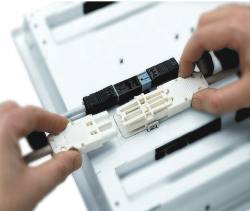Increasing the speed of light

Plug-and-play connection systems such as Wieland’s Gesis range, provide important safety features such as making it impossible to mismatch different connectors.
Plug-and play-connectivity has changed installation practices for lighting, so that projects can be speeded up up enormously, as MARK REDFERN explains.Above the ceiling, deep in the void and unseen by clients, a quiet revolution is taking place. The way lighting fittings are installed is changing fundamentally and irreversibly. The power architecture for light fittings is becoming very different to what it was even 10 years ago. In essence, the concept of modular plug and play is coming to dominate fast-track lighting installations. Instead of wiring together terminals, cables, connector boxes and fittings in the traditional manner with a cable stripper in one hand and a screwdriver in the other, most major lighting installations are simply a plugging together of all the component parts on site.
Strong drivers There are a number of strong drivers for this trend. The first, primarily, is the need to cut installation times. There are still skills shortages in the electrical installation sector, and pay rates for electricians have hardened.

The availability of plug-in connection systems for lighting has allowed lighting manufacturers to invest in complementary luminaires.
As electricians’ time is the major cost of a commercial lighting installation, it is cost-effective to pay a premium for equipment that can be speedily and safely connected on site. This in turn has allowed manufacturers to invest in developing modular products that do just that. The cuts in installation time can be phenomenal. Connecting and fitting a twin-fluorescent luminaire — recessed into a ceiling void — is estimated to take about 40 minutes. Modular plug-and-play methods can cut this time by two thirds, more than justifying the extra capital cost of the power system. Additionally, the installation windows are tighter with fast-track buildings, and the electrical contractor is expected to work in concert with other building services. This is part of the wider trend to off-site fabrication, where modules and pieces of equipment — from chilled beams with multiple services to lighting troughs — are made off site and delivered for immediate installation. Once the reserve of large high-profile fast-track projects, off-site fabrication has now entered the mainstream. And how! The market for off-site fabrication broke the £1 billion mark some years ago, and BSRIA estimates that the distribution systems element of it will continue growing by over 15% a year up to 2010. Over 60% of the building services by value at Heathrow’s £4.2 billion Terminal 5, for instance, are being constructed off site. But also many relatively small-scale offices and retail outlets are featuring large elements of off-site fabrication in their construction. There is also a dramatic reduction in installation errors. As much repetitive electrical installation work has been deskilled over the last decade, this is an important consideration.
Flexibility However, it is not only the need for installation speed and the move to off-site fabrication that is driving the trend to plug and play for lighting installations. There is also the whole new level of flexibility and safety that modularity delivers. Last-minute layout changes, product substitutions, the removal of faulty luminaires and office reconfigurations are all made easier when the installation is plug and play. For instance it is not uncommon for new tenants letting a space to remove the developer-installed lowest-common-denominator Category 2 fittings and replace them with higher-value luminaires. There is one connector profile that dominates all other in the lighting installation sector — the GST18.
Industry standard Designed in the 1980s by the German connector manufacturer Wieland, the GST18 has now become the industry standard across Europe for connections in lighting, and many luminaires aimed at the volume fluorescent market have male GST18 connectors fitted as standard. Apart from their obvious connectivity benefits, these connectors have some crucial safety features. For instance, mismating of different connectors is impossible. All units are mechanically coded, meaning that only matching male and female connectors can be plugged together in the correct pole configuration. They are also colour-coded to speed up matching. However, fast-track lighting installation is not just the GST18.The acceptance of plug and play has created a wide array of components that are designed specifically for the requirements of each individual element of the lighting power distribution, be it emergency lighting power, control etc.
Tailored solutions The days when the installing electrical contractor used the same restricted selection of standard terminal blocks and connector boxes for all the various building services are long gone. In recent years, there has been an explosion in the number of options available. Today a plethora of individually tailored solutions is available for every conceivable lighting installation and control scenario that an electrical contractor could come across. Wieland, for example, has over 5000 different individual components in its building installation technology range — all based on the concept of pluggable connection. The technology can be found in some of the world’s largest and most advanced building projects including the Petronas Towers in Kuala Lumpur and the Commerzbank in Frankfurt.
Mark Redfern is managing director with Wieland Electric Ltd, Unit 5, Riverside Business Centre, Walnut Tree Close, Guildford GU1 4UG.
Related links:




